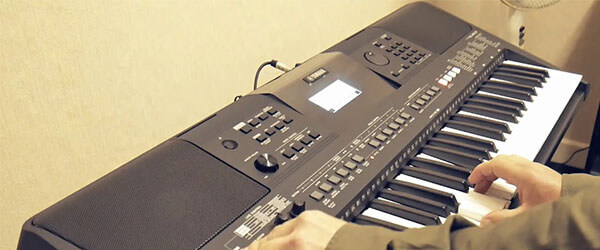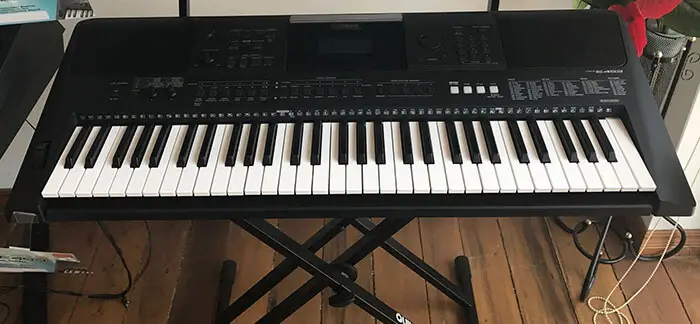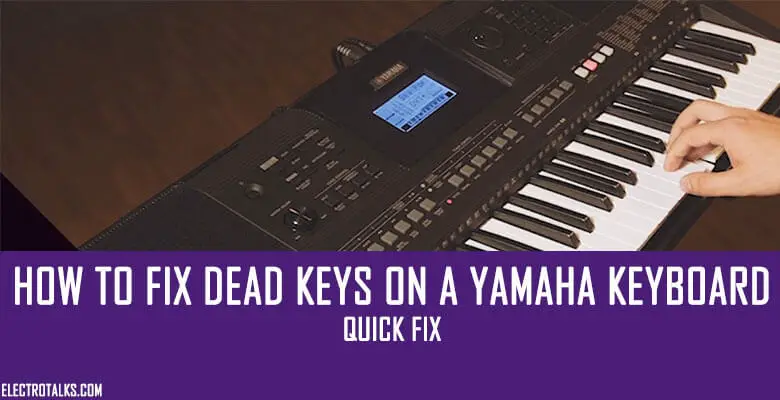“As an Amazon Associate, I earn from qualifying purchases. Without Any Extra Cost to You!”
Like with any musical instrument, Keyboards require the highest care and maintenance, mostly when you bought a secondhand model or it’s becoming old.
The commonly experienced problems with these musical instruments are dead keys. Sometimes the keys of your piano may become reluctant to produce a harmonious melody or audible sound at all.
This kind of problem requires immediate attention for instant repair. Therefore, if you’re experiencing the same problem with your Yamaha Keyboard, below is a complete guide to solving the issue.
Sometimes opting for a replacement can be the suitable and easiest way to fix this problem.
How to fix a dead key on a piano? (Yamaha keyboard)

Step 1: Confirm your safety and necessary tools
Your safety should always come first whenever handling any electronic device. For this reason, you are supposed to disconnect the power cable from the power supply socket and place the keyboard on a smooth and flat surface.
More so, you should also have to make sure that the piano gets cool if you have been using it for prolonged hours.
When it comes to tools, a soldering gun and a solder are required in case there’s a detached wire. Additionally, you don’t have to miss the help of a screwdriver for removing the nuts and screws holding the keyboard together.
Step 2: Determining the problem
The next step will be to determine the problem. Sometimes the issue might be simple after confirming that one of the keyboard’s keys is sticky.
Furthermore, you should check to see whether there’s a broken key on your Yamaha keyboard. Determine why it’s not playing sound properly. However, the named problems in this section call for different solutions.
Step 3: Flipping over the keyboard
Under this step, you are required to turn over the keyboard and inspect for the battery holder. Detach the cover of the battery and carefully inspect for available screws in the bay.
After you are done with the inspection and now you know how many screws are there, it’s now time to take your screwdriver and remove them. I recommend using a Philips screwdriver to do the job for you. I say so because you will be dealing with 19 mm Philip screws.
Now, begin by removing outer screws to access the internal components and determine the possible reason as to why one of your Yamaha keyboard’s keys is dead.
Furthermore, these Pianos always come with longer screws, mostly situated at the middle top and middle of the instrument. Such screws are long, measuring 25.4 mm Phillips screws.
You may interested into speaker for yamaha receiver
Step 4: Remove the cover
You have to carefully detach the cover and place it aside. That’s why it is recommended above to choose a flat and spacious working surface. Search for the contact pad.
Alternatively, you can start by removing the key stop that’s located on the front part of your Yamaha keyboard. It is essential in protecting some useful internal components of the instrument as well as preventing the keys from making unnecessary movements.
After doing so, push down and back on the Yamaha key that you wish to handle. This action is simple as long as the key stop is removed; you simply have to unlock the faulty key from the cut-out.
Sometimes you might be forced to force a small object on the downside of the dead key, separating it from the Yamaha keyboard.
If the problem resides from the internal part like the motherboard, continue with the process
Step 5: Pinching the black locks closed

These clamps are mainly located at the contact pad’s topside and what you need is to pinch them. They always act as lockers, forcing the keyboard body together.
After all the locks are closed, try wiggling the contact pad freely. However, you need to be much more careful of the tiny black hooks situated at the bottom of the keyboard.
Step 6: Lift the contact pad
Now that you are through with contact removal, the next thing will be to lift up the pad. You need to be careful also and remember to hold it gently.
Step 7: Clearing dust
Wiping is necessary immediately after lifting the contact pad. Sometimes dust or debris might be the causatives for a dead key on your Yamaha keyboard. What you need to ensure is therefore to thoroughly clean them out.
Alternatively, if you happen to own an air vacuum, don’t hesitate to use it because its force can help you remove stubborn debris with a lot of ease.
You also need to confirm whether there’s a disconnected or worn-out wire and replace it or solder it into the position. But, if everything is in place, move to the next step.
Step 8: Return the contact pad
If you’ve confirmed there’s nothing serious with your Yamaha’s dead key, fit back the contact pad. You need to do so gently so that you don’t destroy anything but firmly fix the pad.
Step 9: Reassembling
All the components you detached from the keyboard should be put back into their specific position. Now that the contact pad is already into its location, the next thing will be reinstalling the cover.
Screw back all the available screws into their various ports.
What you need to be careful about is that the 25.4 mm Philips screws should be inserted into the top middle and middle part of the keyboard. The remaining screws should go all around the keyboard casing.
Frequently asked questions
How can I fix stuck keys on an electric piano?
Sometimes keys can become sticky and the quickest solution is to wiggle them using your fingers. Press them down and pull them up while wiggling to see whether it can be unstuck.
More so, you may use an available flathead screwdriver to release the stuck keys.
Final words
There’s nothing else that can be more annoying compared to dead keys; it ruins and destroys the purpose and mood to play the piano. Though it’s always advisable to take your disturbed Yamaha keyboard to a local electronic repair shop, sometimes you can do it yourself to cut the bills.
Relying on your DIY skills is always the best option to consider as sometimes the repair shop might be miles away.
